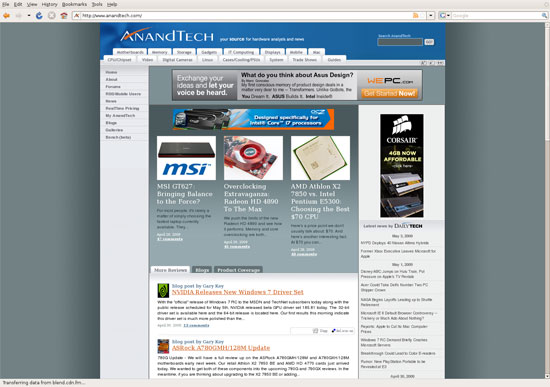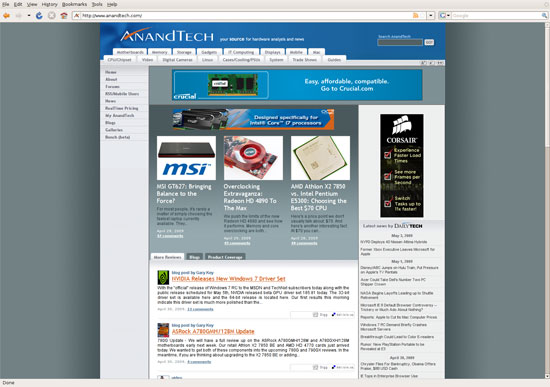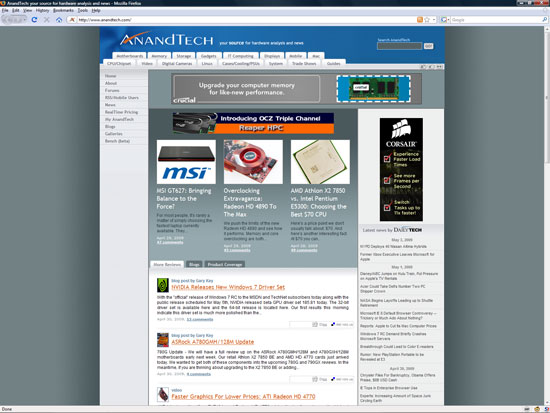Revisiting Linux Part 1: A Look at Ubuntu 8.04
by Ryan Smith on August 26, 2009 12:00 AM EST- Posted in
- Linux
Applications: Web Browsing
Windows Default: Internet Explorer 7
What I use: Firefox 3
Ubuntu Default: Firefox 3
Much to the chagrin of Microsoft, the web browser is turning in to a miniature OS of its own, and in the case of anything that’s not Internet Explorer, it’s a miniature OS that has no allegiance to a real operating system. It’s the primary way to retrieve most information from the internet, applications can be created through AJAX and Flash, video can be watched (see: Hulu). A good cross-platform web browser removes a great deal of the need to use any specific OS, and this is something that works in Ubuntu’s favor.
Ubuntu ships with Firefox 3, Internet Explorer’s loyal opposition and currently the #2 browser on the market. So long as a site isn’t built for IE6 Firefox has great compatibility, good speed, and an army of extensions to add features to it. Since many of you already use it, there’s not a lot to say here: it’s a very solid browser, and something I find to be superior to Internet Explorer.

As I already use Firefox under Windows, the transition here was virtually non-existent. Ubuntu doesn’t have any direct Windows to Ubuntu transition tools, but after moving my Firefox profile from Windows to Ubuntu and reconfiguring a few location-sensitive settings, I was up and going. Internet Explorer users are going to have more of a transition obviously, but it’s not much. All of the major browsers’ core behaviors are the same, which makes it easy to switch among them with little fuss.
At the risk of marginalizing the rest of Ubuntu, I consider Firefox to be one of the core components that makes Ubuntu a success story. Because so much computer use these days is inside a browser, it has become a lynchpin for a good OS. If your browser is bad, then it’s probably hurting the usability of your OS if it means that many users cannot do something they regularly do on another browser. One only needs to look at the early versions of Mac OS X to get a good picture of this, as it shipped with the only-bearable Internet Explorer 5.
There are however a few caveats that I’d like to hit on. Something that continues to throw me for a loop is that while it’s the same Firefox I use under Windows and Mac OS X, it doesn’t necessarily look the same. The rendering engine is the same, but OS differences start to play out here. Mac OS X, Windows, and Ubuntu all render text slightly differently, and in the case of Ubuntu come with a significantly different font set. Because Firefox is at the mercy of the OS for fonts, what you get are small but noticeable differences in how the same page looks.

Firefox with default fonts

Firefox with MS Core fonts

Firefox under Windows
Above we have AnandTech rendered in Firefox 3 on Windows, and Ubuntu. On Windows Firefox uses Times New Roman and Arial for its default fonts, but these fonts do not exist on Ubuntu; rather Ubuntu uses what’s called “serif” and “sans-serif”. This along with how the two OSs differ in font anti-aliasing results in the different look of Firefox under Ubuntu. Having used Windows for a number of years, I have never gotten past the idea of Ubuntu looking “wrong” even though the right look is entirely subjective.
Ultimately I ended up adding the missing fonts by installing the msttcorefonts package, which contains Times New Roman, Arial, and the other “big name” standard fonts. With those installed and Firefox configured to use them, text looks much closer, although not quite the same. It’s a shame that Ubuntu can’t include these fonts by default.
The second caveat is one of performance. When using Javascript-heavy sites in particular, Firefox on Ubuntu seems just a bit slower than under Windows. I had never been able to figure out why until I saw this Slashdot article. Firefox for Linux is not compiled with profile guided optimization, a method of improving the performance of binaries by looking at how they’re used. While Ubuntu compiles their own releases of Firefox, they do the same thing. As a result, there’s a speed difference in Firefox – it’s the same code, but the Windows version is compiled in such a way that it’s faster. As I wrote at the start of this article, I’m not concerned with the performance of Ubuntu or its applications for the most part, and this falls under that notion. Firefox is slower, but not to the point that I care. It’s interesting enough that it bears mentioning, however.
Just to give you an idea of what the speed difference is, here’s a breakout of one of our Firefox benchmarks from the benchmarking section later in this article:

As you can see, in this Javascript-heavy test Firefox on Ubuntu is upwards of 17% slower than it is under Windows. As this performance gap manifests itself largely under Javascript-heavy situations; regular browsing doesn’t show nearly the difference. Flash is also slower, but this has nothing to do with Firefox and more to do with Flash’s mediocre performance under any OS that isn’t Windows.
The last caveat is one of how Ubuntu’s distribution model becomes strained when it comes to Firefox. Ubuntu Hardy shipped nearly 2 months before Firefox 3 did. But because Ubuntu is meant to be a stable platform they still needed to package Firefox 3 with the OS, so Firefox 3 Beta 5 was included. If we had done this article a month after Hardy launched as intended, I’d have few nice things to say. Firefox 3 Beta 5 combined with Adobe Flash 9 was buggy, unstable junk. Canonical made the right decision as the final version of Firefox 3 turned out well, but it highlights the pitfalls of including 3rd party software with the OS.
The flip side of this caveat is that Firefox 3.5.x has superseded 3.0.x as the newest Firefox branch, which means that only 3.0.x versions are being pushed out to Hardy. This means if you want to take advantage of any of Firefox’s newest features such as the new javascript engine, you’ll need to install a 3.5.x build separately, ideally through a PPA package so that it cleanly replaces the default version of Firefox.
But even with those caveats, none of them are serious issues. Firefox 3 is still a fantastic browser and there’s nothing else I’d rather have on Ubuntu.
Final Verdict: Meets My Needs










195 Comments
View All Comments
Eeqmcsq - Wednesday, August 26, 2009 - link
for your time spent on writing this article. I've made the jump to from Windows to Ubuntu (and Xubuntu for my older computers) back around 7.10 and 8.04 and I went through some of the headaches in adjusting to Ubuntu, but I eventually solved all of them and I'm quite settled in now.One comment about finding help in the form of command line instructions, rather than GUI instructions. GUI instructions for Ubuntu would not be useful for Kubuntu or Xubuntu, since they use different window managers. The command line solutions usually work for all three.
Also, boot times were noticeably improved in 9.04. Perhaps you can run a quick retest on it.
And you CAN install stuff when using the live CD. I've installed a couple of temperature monitoring utilities when I was stress testing my motherboard.
Finally, thanks again for writing such a thorough look into your Ubuntu experiences. It was a great read in seeing how far Ubuntu has come and what it still lacks.
fepple - Thursday, August 27, 2009 - link
Yeah, you can set the APT sources to use a CD. There is an option for it 'system' > 'administor' > 'software source', or you can edit the /etc/apt/sources.list fileclarkn0va - Wednesday, August 26, 2009 - link
[quote]since SMB is the predominant protocol for consumer file server gear, it’s a fair test of such use.[/quote]While this comment is not false, it presents a lazy approach to comparison; it's a one-sided contest, and Linux, pitted against Windows on home turf, doesn't stand much of a chance.
You as much as acknowledge this in the article, so why not provide some counterpoint? For example, consumer file server gear, even if it supports SMB almost ubiquitously, is usually *nix-based. So instead of just showing Windows and Linux clients interacting with Windows servers, show them interacting with *nix servers as well. Do some NFS transfers as well; NFS is well supported in consumer NAS these days.
You also really missed the boat on the video drivers. 8.04 was not the first Ubuntu release to include the Restricted Drivers Manager (known simply as "Hardware Drivers" in later releases). This handy app will identify hardware, such as AMD and NVIDIA GPUs, that can take advantage of proprietary drivers, and will offer to to install the same via synaptic (APT) with just a click of the mouse. No CLI, no headaches.
Still, a thorough review, and generally well-researched. I'm looking forward to the 9.04 follow-up.
Since you mentioned hardware HD decoding, I recommend taking a look at smplayer from the testing ppa (https://launchpad.net/~rvm/+archive/testing)">https://launchpad.net/~rvm/+archive/testing). Unfortunately vdpau doesn't work with the nvidia blobs in the default Ubuntu repos, but I believe there's a PPA providing vdpau-compatible blobs for anybody not wanting to do CLI installs.
db
VaultDweller - Wednesday, August 26, 2009 - link
[quote]While this comment is not false, it presents a lazy approach to comparison; it's a one-sided contest, and Linux, pitted against Windows on home turf, doesn't stand much of a chance. [/quote]This isn't Linux pitted against Windows on home turf, it's Linux pitted against Windows in the real world.
clarkn0va - Wednesday, August 26, 2009 - link
Well, no doubt SMB is the dominant method of sharing files for consumers in general. Obviously comparing Linux to Windows makes sense in a world where Windows is the incumbent, but it's not the whole story.I hope Part 2 will address some of the objective benefits of Ubuntu, and not fall into the trap of "worse because it's not the same as Windows".
VaultDweller - Wednesday, August 26, 2009 - link
I agree in principle, but there has to be a distinction between "Worse because it's not compatible with Windows," "Worse because it's not as easy as Windows," and "Worse because it's not the same as Windows." Die-hard *nix advocates tend to dismiss the first two as if they were the latter, and this tends to undermine their argument.Also, in some cases "Worse because it's not the same as Windows" can be a valid point, because the public has been trained to the point that the Windows way is the "intuitive" way. Of course, this isn't truly intuitive, as people who learned Linux first would find Linux methodologies more intuitive - but that's largely a moot point, as that's not the reality we live in today. You could say the same thing about the color red - in the western world, when we see red we can intuitively guess that it means Stop, or Warning, or Error, etc. The fact that this is not an understanding we're born with but rather a socially acquired intuition does not mean it would be any easier to suddenly change the color of traffic lights and expect people to adjust without problems.
Ryan Smith - Wednesday, August 26, 2009 - link
All of the NAS gear I can get my hands on is either SMB only, or is a Time Capsule which is SMB + AFP. I don't have anything that does NFS, which isn't so much a comment on testing (I could always set up another box) as it is usefulness. NFS just isn't common on consumer gear; SMB is a more important metric if you're looking at file transfer performance, because that's what most people are going to be working with. This doesn't preclude doing NFS at a later time though.And the Restricted Drivers Manager is limited to the drivers in the Hardy repository, which means they're a year+ out of date.
amrs - Wednesday, September 30, 2009 - link
Interestingly, if one checks the SmallNetBuilder NAS charts, it looks like out of 87 NAS devices, 49 have NFS. 56% in other words. And you say NFS isn't common? Really now? Seems a little biased to me.ekul - Wednesday, August 26, 2009 - link
While a lot of your issues have complicated solutions or lengthy technical backstories I can solve your complaint of smb shares mounted in nautilus not being useful in non-gtk applications in one simple command (or as you seem to hate commands the gui can do it too).theory: make a symlink to the directory nautilus mounts to so it can be easily accessed. Symlinks to directories or files are transparently (to users and applications) identical to the location they refer to. Windows doesn't have symlinks (only useless shortcuts) so it isn't surprising you were not aware to do it.
howto: gvfs uses the directory /home/$USER/.gvfs as a mount point so link to it:
ln -s ~/.gvfs ~/linkname
howto gui: in nautilus go to your home folder then choose view -> show hidden files. Right click on .gvfs and choose make link. Then you can rename the link to whatever you want and hide hidden files again.
hint: symlinks are your best friend. My home dir is littered with links to places on the filesystem I visit a lot to avoid a lot of clicking/typing
Ryan Smith - Wednesday, August 26, 2009 - link
I suddenly feel very humiliated...The symlink is a very elegant solution, I'm embarrassed I didn't think of that myself. It's a bit of a lousy solution in that there even needs to be a solution, but as far as things go that's a very insightful suggestion.